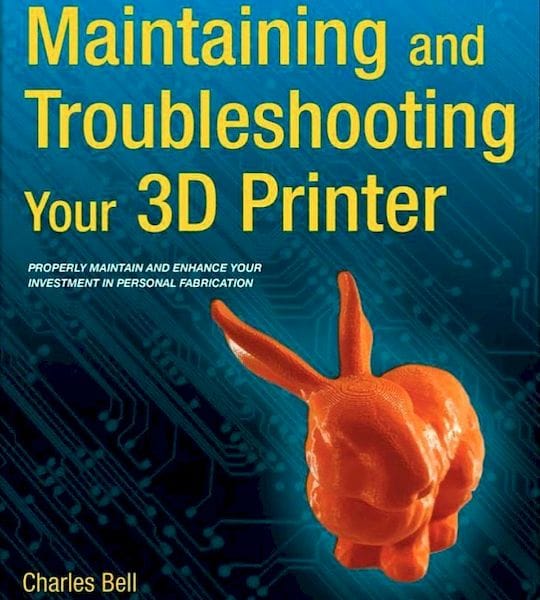
This week’s selection is the practical “Maintaining and Troubleshooting Your 3D Printer” by Charles Bell.
Desktop 3D printers are utterly unlike most common machines in that they often don’t work properly. A 2D paper printer, for example, is (usually) a highly tuned machine that works more or less reliably, even though there are multiple mechanical and chemical operations taking place in careful sequence inside.
We’re used to that style of machine. That is, machines that work. When confronted with less reliable machines, we get frustrated.
And that is, unfortunately, the current state of affairs with desktop 3D printers (and larger ones often as well). They simply are not as reliable as we might expect.
This is due to the mechanical and chemical processes that must take place within their enclosures. While machine designers have clearly improved the equipment very substantially since the early days, there are still plenty of challenges when operating the devices.
Every 3D printer operator passes through a challenging learning process when using their device. Yes, it may work well on the first try, but it may not be an optimal result. There are things to discover when using and maintaining the machine.
Operators inevitably discover that “things work better if I do this”, or “I’d better adjust this before printing”, or “I have to clean this before printing”, and much more. The process of learning all the trivia required to properly operate a device can be extremely time consuming, and may take weeks or even months.
That’s why I like this book, as it offers a method of short circuiting at least part of that lengthy process. Bell provides some advice for each of the major experience categories one encounters when using desktop 3D printers.
Of course, Bell starts the book with the basics of 3D printing, obtaining a machine and some initial tips on 3D design and machine configuration.
But then we get into the “real stuff”, as he then has an entire section on troubleshooting. The overview:
Part II provides a look into the baffling world of troubleshooting 3D printers and print quality. It includes chapters on diagnosing hardware and software problems. You will learn how to diagnose print quality issues like first-layer adhesion (lifting) and other anomalous print artifacts.
3D printers, like any machine, require periodic maintenance to ensure not only proper operation but prevent damage to the components. Many operators don’t bother maintaining their machine, but over time payment for that lack will be demanded when the machine breaks, perhaps irrevocably so.
Bell’s third part gets into maintenance procedures:
Part III will get you familiar with the concepts of maintaining a 3D printer. This includes alignment, adjustment, cleaning, and repairing the components of your printer. You will also learn how to extend the life of your 3D printer by upgrading and enhancing features.
That’s all good advice that every 3D printer operator should consider. Having owned a large number of machines myself, I can tell you that maintenance of these machines will require far more work than you imagine and certainly more than most devices you operate.
This book is not for 3D design, but instead gets at a perhaps more critical aspect of 3D printing: making it work, and work correctly.
Via Amazon

